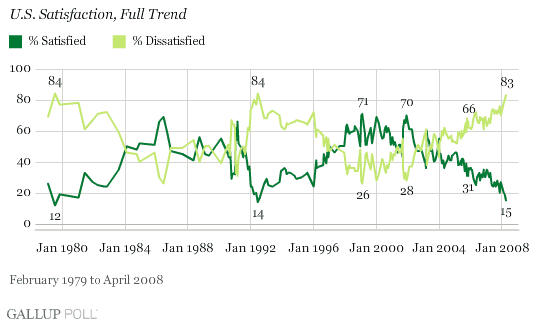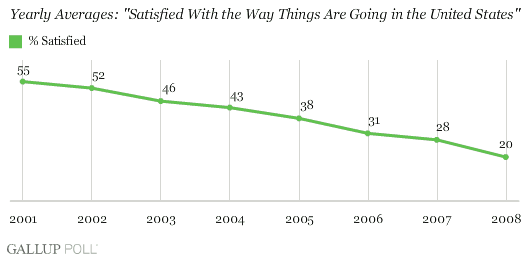PRINCETON, NJ -- The percentage of Americans who are satisfied with the way things are going in the United States is now at only 15%, according to the latest Gallup Poll update. This marks the lowest reading on this measure since June 1992, and the third lowest Gallup has recorded since 1979.

Satisfaction has been falling each month this year, beginning with an already-low 24% in January, dropping to 20% in February, 19% in March, and now this month's 15%.
Just before George W. Bush took office as president in January 2001, 56% of Americans were satisfied with the way things were going in the United States. That percentage soared to a near-record-high 70% in December 2001, a few months after the Sept. 11 terrorist attacks and the aggressive U.S. response in Afghanistan. (The record-high satisfaction rating across the 29 years in which Gallup has been using this measure is 71%, which came in February 1999 as President Bill Clinton was acquitted by the U.S. Senate on impeachment charges.) The average satisfaction rating for all of 2001 was 55%. Satisfaction for each year since then has declined, culminating in the 28% average for 2007 and the 20% average satisfaction in the first four months of this year.

Gallup began asking this satisfaction question in February 1979, and by July of that year recorded what still stands as the all-time low on the measure, 12%, in the midst of worries about the economy and skyrocketing gas prices. The second-lowest measure of 14% came in June 1992, during the final year of the George H. W. Bush administration and another time of perceived economic recession.
What's Behind Low Satisfaction Levels?
One does not have to go much further than the daily newspaper headlines or the lead stories on cable news channels to discern proximate causes for the extraordinarily low levels of satisfaction with the way things are going in the United States today. But Gallup's monthly measure of what Americans themselves perceive to be the most important problem facing the country provides precise figures that help explain why the public is so negative about the current state of affairs in the United States.

There has been a steady rise in the percentage of Americans mentioning some aspect of the economy as the nation's top problem over the past six months, from 22% in October 2007 to 61% in this most recent April 2008 measure. About two-thirds of these are simply "the economy," with an additional 9% naming the price of gas, 6% unemployment, and 4% the high cost of living and inflation.
The second-most-commonly mentioned problem is Iraq, at 23%. The percentage mentioning Iraq as the nation's top problem has held fairly constant since last November, even as the percentage of Americans mentioning the economy has increased on a month-by-month basis.
Other problems mentioned by 5% or more of Americans include healthcare, dissatisfaction with government, and immigration.
Discussion
Gallup data -- and a review of news headlines -- suggest that the most important reason so many Americans are dissatisfied with the way things are going in the United States is the economy. The number of Americans mentioning some aspect of the economy as the nation's top problem has almost tripled in the last six months, and the economy now far eclipses the war in Iraq as the American public's dominant perceived problem. Additionally, Gallup's tracking measures of the economy continue to show consumer confidence at or near all-time lows.
Not surprisingly, the last two times satisfaction levels were lower than the current 15% were also times when the U.S. economy was perceived to be the dominant problem facing the nation -- in 1992 and 1979.
The currently low satisfaction level is concurrent with President Bush's lowest job approval rating of his administration. Low satisfaction levels in 1992 and 1979 were major factors in both Jimmy Carter's and George H.W. Bush's failure to be re-elected to second terms as president. The current President Bush cannot run for re-election. It remains to be seen whether voters will take out their frustrations by electing a Democrat to the presidency, but if they are in the mood to punish Bush's party, it could make John McCain's presidential bid an uphill challenge (though he currently is highly competitive with the Democratic candidates in presidential election trial heats). Democrats currently control both houses of Congress, but Gallup's generic ballot tests of congressional election voting preferences suggest that voters still favor Democratic control of Congress and thus may not hold congressional Democrats accountable for the current situation.
Survey Methods
Results are based on telephone interviews with 1,021 national adults, aged 18 and older, conducted April 6-9, 2008. For results based on the total sample of national adults, one can say with 95% confidence that the maximum margin of sampling error is ±3 percentage points.
Interviews are conducted with respondents on land-line telephones (for respondents with a land-line telephone) and cellular phones (for respondents who are cell-phone only).
In addition to sampling error, question wording and practical difficulties in conducting surveys can introduce error or bias into the findings of public opinion polls.
